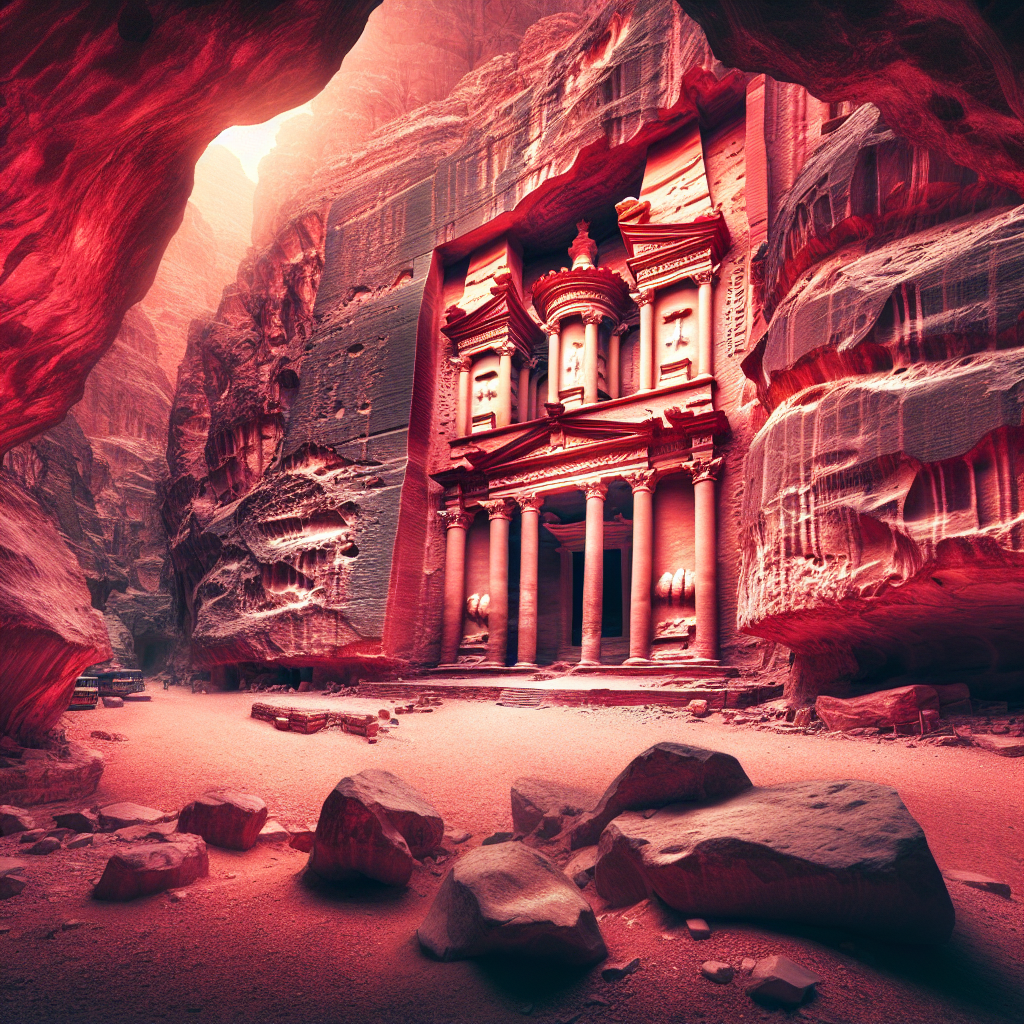Unveiling the Mysteries of Petra
Welcome to the enchanting world of Petra, a UNESCO World Heritage Site nestled in the desert canyons of Jordan. Known as the Rose City due to the rosy hue of its rock-cut architecture, Petra is a place shrouded in mystery and wonder, waiting to be explored and uncovered.
History and Origins
Believed to have been established as early as 312 BC, Petra was the capital of the Nabatean Kingdom, a thriving civilization that controlled the trade routes of the ancient Middle East. Its strategic location and ingenious water management systems allowed Petra to flourish as a center of commerce and culture.
Architectural Marvels
The most iconic structure in Petra is the Treasury, a beautifully carved façade that served as a tomb for Nabatean kings. As you wander through the Siq, a narrow gorge that leads to Petra's main entrance, you'll be greeted by stunning rock-cut tombs, temples, and amphitheaters that showcase the architectural prowess of the Nabateans.
Hidden Secrets and Legends
Beyond the well-known landmarks of Petra lie hidden secrets and intriguing legends. From the High Place of Sacrifice offering panoramic views of the city to the Monastery perched high on a hilltop, each corner of Petra holds tales of its mysterious past waiting to be unveiled.
Exploration and Adventure
Embark on a journey of discovery as you hike through winding trails, climb ancient stairways, and uncover hidden chambers within Petra's rocky cliffs. Whether you're a history enthusiast, an avid adventurer, or a curious traveler, Petra offers a unique blend of exploration and excitement.
Preservation and Conservation
As one of the world's most treasured archaeological sites, Petra faces the challenges of preservation and conservation. Efforts are ongoing to protect and safeguard the fragile rock-cut structures, while ensuring that future generations can continue to marvel at the wonders of this ancient city.
Plan Your Visit
Ready to embark on an unforgettable journey to Petra? Explore our website for practical information on how to get there, where to stay, what to see, and tips for making the most of your visit. Unveil the mysteries of Petra and immerse yourself in a world of history, culture, and adventure.
Unveiling the Mysteries of Petra
Welcome to the ancient city of Petra, nestled in the rocky landscapes of Jordan. This UNESCO World Heritage site is shrouded in mystery and intrigue, drawing in visitors from around the globe to uncover its secrets.
Believed to have been established as early as 312 BC, Petra served as the capital of the Nabatean Kingdom. Its strategic location along the trade routes allowed it to prosper and grow into a thriving city, with its stunning architecture and intricate carvings showcasing the advanced engineering skills of its inhabitants.
History and Significance
The history of Petra is rich and complex, with influences from various ancient civilizations such as the Greeks, Romans, and Egyptians. The city's most iconic structure, the Treasury, is a testament to the wealth and grandeur of the Nabatean people, adorned with intricate facades that have stood the test of time.
Throughout the centuries, Petra went through periods of prosperity and decline, eventually fading into obscurity until its rediscovery by the Western world in the early 19th century. Today, archaeologists continue to uncover new findings that shed light on the daily life and customs of the people who once inhabited this majestic city.
Exploring Petra
Visiting Petra is like stepping back in time, as you wander through its narrow canyons and marvel at the rose-colored rock-cut architecture. The Siq, a winding canyon that leads to the city center, creates a dramatic entrance that leaves visitors in awe of the ancient craftsmanship.
Aside from the Treasury, other notable sites within Petra include the Monastery, the Royal Tombs, and the Roman Theater. Each structure offers a glimpse into the past and allows visitors to imagine what life was like during the city's prime.
Preservation Efforts
As one of the most iconic archaeological sites in the world, Petra faces constant threats from natural erosion, tourism impact, and urban development. Conservation efforts are ongoing to ensure that this historical treasure is protected for future generations to appreciate and enjoy.
By implementing sustainable tourism practices and engaging with local communities, authorities are working to strike a balance between preserving Petra's cultural heritage and allowing visitors to experience its wonders firsthand.
Conclusion
Unveiling the mysteries of Petra is a journey that takes you deep into the heart of ancient history and architectural ingenuity. From its enigmatic beginnings to its present-day challenges, Petra remains a place of wonder and fascination for all who are fortunate enough to explore its timeless beauty.
Plan your visit to Petra today and embark on an adventure that will transport you to a world unlike any other, where the past comes alive amidst the stunning red rocks and ancient ruins of this extraordinary city.
Unveiling the Mysteries of Petra
Petra, a UNESCO World Heritage Site, is a breathtaking ancient city located in Jordan. Known as the Rose City due to the color of the stone from which it is carved, Petra is a symbolic and archaeological treasure that has captivated visitors for centuries.
History of Petra:
- Established possibly as early as 312 BC, Petra was the capital of the Nabatean Kingdom.
- It served as a major trading hub and flourished under Nabatean rule, showcasing impressive architecture and advanced water management systems.
- After falling into disuse, Petra was rediscovered by the Western world in 1812, further fueling its mystique and allure.
Key Attractions in Petra:
- The Siq: A narrow gorge that serves as the main entrance to Petra, creating a dramatic and memorable approach to the city.
- The Treasury (Al-Khazneh): One of the most famous and elaborate structures in Petra, carved into the rock face, possibly as a mausoleum or temple.
- The Monastery (Ad Deir): Another impressive structure located high in the mountains, offering stunning views of the surrounding desert landscape.
- The Royal Tombs: A series of grand burial sites carved into the cliffs, showcasing the architectural prowess of the Nabateans.
Archaeological Discoveries:
- Ongoing excavations and research at Petra continue to reveal new insights into the city's history and significance.
- Recent discoveries include hidden chambers, ancient pottery, and evidence of a complex water management system that sustained the city.
- Archaeologists are also exploring the remnants of Petra's vibrant past, shedding light on its role in the ancient world.
Visitor Experience:
- Today, Petra welcomes tourists from around the globe, offering guided tours, hiking trails, and opportunities to immerse oneself in its rich history.
- Visitors can marvel at the intricate rock-cut architecture, explore hidden passageways, and witness the interplay of light and shadow throughout the site.
- Guides provide insights into Petra's past, highlighting its cultural significance and the stories behind its most iconic structures.
Preservation Efforts:
- Recognizing the importance of Petra's preservation, conservationists and authorities are working to protect the site from natural erosion and human impact.
- Efforts include stabilizing structures, monitoring foot traffic, and implementing sustainable tourism practices to ensure Petra's longevity for future generations.
- Collaborative initiatives aim to safeguard Petra's unique heritage while balancing the needs of tourism and environmental conservation.
Unveiling the Mysteries of Petra
Petra, an ancient city carved into rose-hued rock cliffs in southern Jordan, is one of the most famous archaeological sites in the world. Known as the Rose City, Petra is a UNESCO World Heritage site and has captivated visitors for centuries with its stunning beauty and intriguing history.
History of Petra
Founded by the Nabateans around 312 BC, Petra served as the capital of their prosperous kingdom. The city thrived as a major trading hub, strategically located along caravan routes linking the Arabian Peninsula, Egypt, and Syria.
Architectural Marvels
The most iconic structure in Petra is the Treasury, carved into the rock face with intricate Greek-influenced architecture. The city also features a Roman-style theater, temples, tombs, and other impressive monuments that showcase the advanced engineering skills of the Nabateans.
Lost City Rediscovered
Although Petra was a well-known trading center in antiquity, the city was eventually abandoned and forgotten by the outside world. It wasn't until the 19th century that Swiss explorer Johann Ludwig Burckhardt rediscovered Petra, bringing global attention to this hidden gem.
Mysteries and Legends
Despite extensive research and excavation, many mysteries surrounding Petra remain unsolved. The city's intricate water management system, rock-cut tombs, and religious significance continue to intrigue archaeologists and historians, sparking numerous theories and legends.
Modern Exploration and Preservation
Today, Petra attracts hundreds of thousands of visitors each year, drawn by its unique beauty and historical significance. Efforts are ongoing to preserve and protect the fragile ruins, ensuring that future generations can continue to marvel at the wonders of this ancient city.
Conclusion
Unveiling the mysteries of Petra is a journey through time, uncovering the secrets of a once-thriving civilization and the breathtaking achievements of ancient architects and artisans. Visiting Petra is an unforgettable experience that allows travelers to immerse themselves in the rich history and beauty of this remarkable site.
Unveiling the Mysteries of Petra
Petra, the ancient city carved into the rose-red cliffs of southern Jordan, continues to captivate visitors from around the world with its awe-inspiring beauty and rich history. This UNESCO World Heritage site is a testament to the ingenuity and craftsmanship of the Nabatean civilization, who established Petra as their capital city around the 6th century BC.
Historical Significance
Exploring Petra is like stepping back in time, as visitors can wander through the city's intricate rock-cut tombs, temples, and theaters. The iconic Treasury, carved into the cliff face, is perhaps the most famous of Petra's monuments, drawing in crowds with its intricate façade and mysterious aura.
Architectural Marvels
The architecture of Petra is a blend of Nabatean, Hellenistic, and Roman influences, showcasing the city's role as a crossroads of civilization. From the impressive colonnaded street to the majestic Monastery perched high above the valley, every structure in Petra tells a story of innovation and cultural exchange.
Natural Beauty
Beyond its man-made wonders, Petra is also renowned for its breathtaking natural surroundings. The towering cliffs, narrow gorges, and expansive desert landscapes create a stunning backdrop for the ancient city, inviting visitors to marvel at the harmonious integration of nature and architecture.
Preservation Efforts
In recent years, efforts have been made to preserve and protect Petra from the effects of modernization and tourism. Sustainable initiatives aim to ensure that future generations can continue to experience the magic of Petra while safeguarding its cultural integrity and natural environment.
Visiting Petra
For travelers seeking an unforgettable experience, a visit to Petra promises adventure, discovery, and a deeper appreciation for the wonders of the ancient world. Whether exploring the Siq, hiking to the High Place of Sacrifice, or simply soaking in the atmosphere of this enchanting site, Petra never fails to leave a lasting impression.
In conclusion, Petra stands as a testament to human artistry, resilience, and cultural exchange. Unveiling the mysteries of Petra is not just about exploring an ancient city; it is about immersing oneself in a world where history and nature converge to create a truly unforgettable experience.




